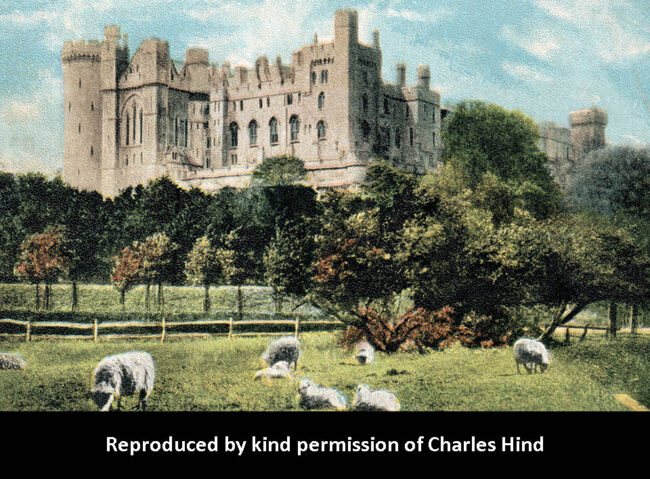
The house from a 1902 postcard
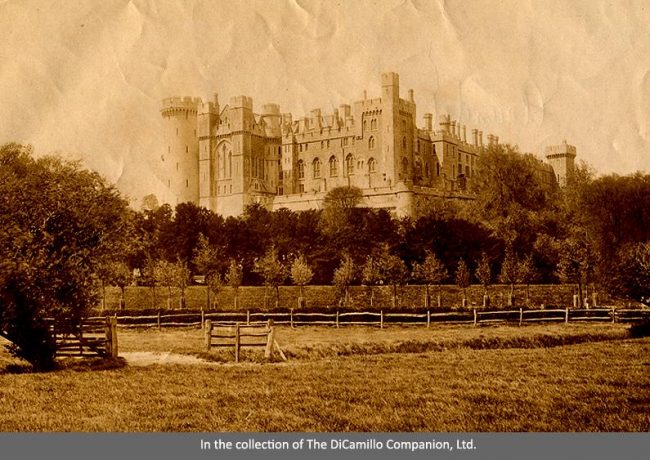
The castle from a circa 1900 photograph published by Francis Firth & Co.
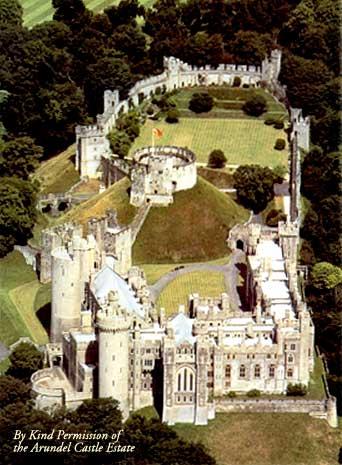
The castle from the air
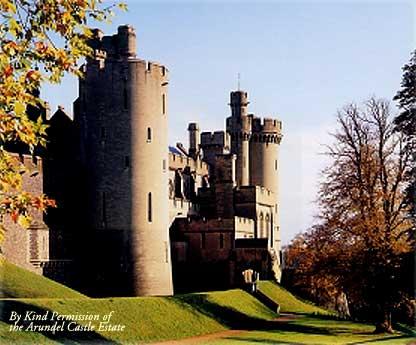
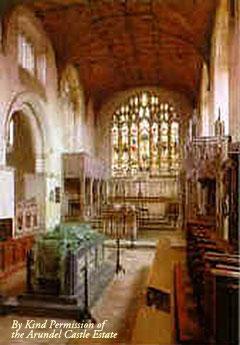
The Fitzalan Chapel
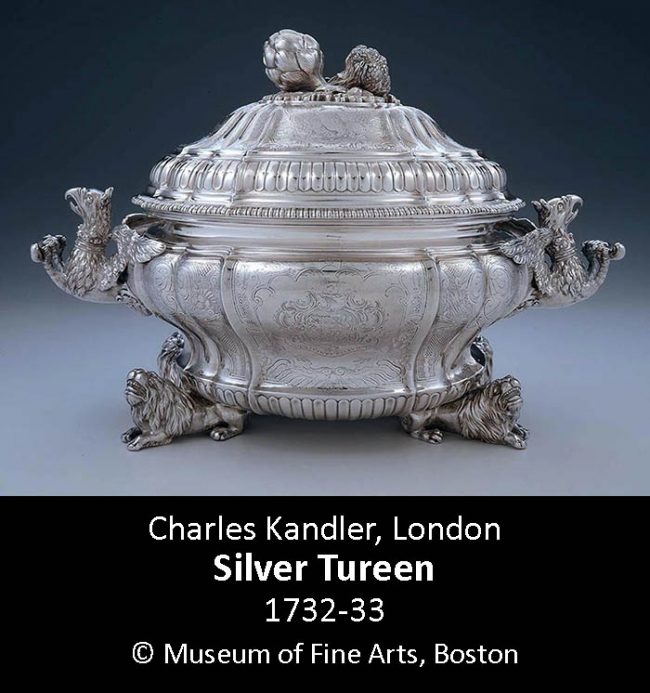
This tureen, formerly in the collection at Arundel, is today in the collection of the Museum of Fine Arts, Boston.
Built / Designed For: Roger de Montgomery
House & Family History: Home of the dukes of Norfolk and earls of Arundel for over 800 years, Arundel Castle, situated in magnificent grounds overlooking the River Arun in West Sussex, was built at the end of the 11th century by Roger de Montgomery, Earl of Arundel. At Christmas 1067 William the Conqueror created Roger Earl of Arundel and gave him a third of the county of Sussex as a reward for his stewardship of Normandy while William was taking care of conquering England. Roger very likely built the original motte and bailey castle on the site, probably of earth and timber, making Arundel older than Windsor Castle (only the gatehouse remains today from Roger's time). Queen Adeliza of Louvain, the widow of Henry I, was granted the castle and lands as her dowry in 1138. Henry II added, circa 1170-circa 1190, other towers and a keep on top of the motte. In 1643, during the Civil War, the castle was badly damaged; it was restored by the 8th, 11th, and 15th Dukes in the 18th and 19th centuries. The duke of Norfolk is the premier duke of the United Kingdom (the oldest non-royal dukedom in England), the title having been conferred on Sir John Howard in 1483 by his friend, King Richard III. The first time the dukedom was created was in 1397, when Richard II conferred the title on Thomas de Mowbray; after the Mowbray line died out it was bestowed upon the Howard family (before this the title was created, for the second time, in 1481 for Richard of Shrewsbury, Duke of York, the second son of Edward IV. One of the famous Princes in the Tower, the Duke of York’s titles were declared forfeit by his uncle, Richard III, when he seized the crown and declared the Duke of York [and his brother, Edward V] illegitimate). The dukedom carries with it (since 1672) the hereditary office of earl marshal of England. This means that the duke is in charge of state ceremonies, such as the coronation and funeral of the sovereign and such occasions as the sovereign declares shall be a state occasion, e.g., the investiture of a prince of Wales, or a state funeral for a notable like Sir Winston Churchill. As earl marshal, the duke is head of the College of Arms, founded in 1484, the official authority on heraldry and genealogy in England and Wales. In addition, through his subsidiary title of earl of Arundel, the duke of Norfolk is also the premier earl of England. There have been a number of historically famous members of the Howard family, including Lord Howard of Effingham, who, with Francis Drake, repelled the Spanish Armada; Henry Howard, Earl of Surrey, one of the founders of English Renaissance poetry; and the 3rd Duke of Norfolk, uncle of Anne Boleyn and Catherine Howard, both of whom became wives of King Henry VIII. Queen Victoria came from Osborne House with her husband, Prince Albert, for a three-day visit in December of 1846. In honor of the queen and prince's visit, the 13th Duke commissioned a complete set of gold and white Elizabethan style furniture, including a massive bed, from the fashionable London decorator George Morant. The queen's portrait by William Fowler was commissioned by the 13th Duke in 1843. During World War II Arundel was taken over (from 1940 until 1945) by the British Army and occupied by British, Canadian, and American troops. (We are most grateful to the Arundel Castle Estate and Eileen Wallace for contributing the vast majority of this history of Arundel Castle).
Collections: The library at Arundel is one of the most important country house libraries in Britain. It contains 10,000 books and is particularly rich in Catholic history. Arundel has among its treasures a collection of fine furniture dating from the 16th century, portraits by van Dyck (eight), Gainsborough, Reynolds, Mytens, and Lawrence, and important tapestries and clocks. Personal possessions of Mary, Queen of Scots, and a selection of historical, religious, and heraldic items are also in the collection. Most of the famous collection of ancient marbles (the Arundel Marbles) formed by Thomas Howard, 14th Earl of Arundel ("the Collector Earl"), is today in the collection of the Ashmolean Museum, Oxford (it was given to the Ashmolean in 1677 by the earl's grandson); a few marbles remain today at Arundel Castle. At 10:30 PM on May 21, 2021 thieves broke into the castle and forced open a display cabinet and stole gold and silver objects worth more than £1 million, including coronation cups and the gold rosary beads carried by Mary, Queen of Scots, at her execution in 1587. The archives at Arundel are also home to the Bryant Index of Country Houses, a project started in the mid-20th century by Gilbert Ernest Bryant (1878-1965) to document British country houses.
Garden & Outbuildings: On May 14, 2008 Charles, Prince of Wales, opened the new Collector Earl's Garden at Arundel Castle. The garden, designed by the husband-and-wife team of Isabel and Julian Bannerman, was conceived as a light-hearted tribute to Thomas Howard, 14th Earl of Arundel (1585-1646), known as "the Collector Earl." Lord Arundel is considered the first of the great English art collectors, particularly noted for his collection of antique marbles, once housed at Arundel House, London (currently the site of the Howard Hotel and Temple Underground Station). His collection is today primarily at the University of Oxford (Ashmolean Museum) and the library of the Royal Society (many of his portrait paintings, as well as other pieces from his collection, form the basis of the collection at Arundel Castle; at his death the Collector Earl had a collection of 700 paintings, together with significant collections of prints, drawings, books, and antique jewelry). Lord Arundel died in exile in Padua, Italy, during the English Civil War, and, though his body was brought back to England and buried in the Fitzalan Chapel at Arundel, the ornate tomb he specified in his will was never built. This garden, adjoining the chapel, can now be interpreted as his memorial. The formal Jacobean garden is an artistic re-creation of what the Collector Earl's formal garden at Arundel House in London may have been like. The domed pergola and fountains are based on those seen in the garden vista of Arundel House in the background of the famous Mytens portrait of the Countess of Arundel (today in the drawing room at Arundel Castle), while the green oak gateways and pavilions are based on Inigo Jones's designs for Arundel House. The planting is restrained (no flowers) and the garden is divided into formal courts with a center canal pond and a tufa-lined cascade. The centerpiece is the rock work mountain, planted with palms and rare ferns, which supports a green oak version of Oberon's Palace. The other-worldly palace is based on the famous spectacle designed by Inigo Jones for Prince Henry's masque on New Year's Day 1611. Inside the shell-lined interior is a stalagmite fountain that features the dancing coronet, a gold ducal coronet that rises and falls, held in place by pressure from the fountain. The new garden occupies about a third of the area of the Georgian and Victorian walled kitchen garden, which, for the last 40 years, had been an unattractive parking lot (the remaining two-thirds of the kitchen garden was converted into an organic kitchen garden). Hiorn's Tower was built in 1790 in the Gothic style by Francis Hiorn.
Chapel & Church: The Fitzalan Chapel was founded in 1380 by Richard, 4th Earl of Arundel, as a collegiate chapel served by secular canons. In the late Middle Ages the chapel was a noted center of music, with a fine choir, for which much early English polyphony was especially composed. In the reign of Henry VIII the college was dissolved as part of the Dissolution of the Monasteries, with the result that the chapel and other buildings were returned to the family, where they have remained the private property of the earls of Arundel and the dukes of Norfolk ever since. In 1643 the chapel was badly damaged in the Civil War, and, in 1782, the original carved timber roof was destroyed. The Fitzalan Chapel was restored in stages throughout the 19th century, with the 14th Duke adding the mausoleum on the south side to the designs of Matthew Ellison Hadfield, and the 15th Duke undertaking a major restoration in 1886 to the plans of Charles Buckler. In 1879, in an action heard before Lord Chief Justice Coleridge, it was determined that the Fitzalan Chapel did not form part of the parish church, but was an independent ecclesiastical structure. Thus, the chapel remained Catholic, an unusual, if not unique, anomaly in England. The Fitzalan Chapel is still used as the burial place of the dukes of Norfolk, and a number of masses are said at the chapel each year for dukes' souls, in accordance with the intention of the founder.
Architect: Matthew Ellison Hadfield
Date: 19th centuryArchitect: Robert Abraham
Date: 1791-1815Architect: Charles Alban Buckler
Date: 1886-1903John Bernard (J.B.) Burke, published under the title of A Visitation of the Seats and Arms of the Noblemen and Gentlemen of Great Britain and Ireland, among other titles: Vol. I, p. 87, 1852.
John Preston (J.P.) Neale, published under the title of Views of the Seats of Noblemen and Gentlemen in England, Wales, Scotland, and Ireland, among other titles: 2.S. Vol. IV, 1828.
Country Life: XXXVI, 746, 782 plan, 814, 853 [Furniture], 1914. CLXXIII, 196 [Collection], 280 [Collection], 332 [Collection], 1983.
Title: Arundel Castle Guidebook - NEW
Author: Robinson, John Martin
Year Published: NA
Reference: pgs. 19, 28-29
Publisher: Sussex: Arundel Castle Trustees
ISBN: NA
Book Type: Light Softback
Title: Art Treasures of England: The Regional Collections
Author: Waterfield, Giles; et al.
Year Published: 1998
Reference: pg. 18
Publisher: London: Royal Academy of Arts
ISBN: 0900946598
Book Type: Softback
Title: Buildings of England: Sussex, The
Author: Pevsner, Nikolaus; Nairn, Ian
Year Published: 1973
Reference: pgs. 91-93
Publisher: London: Penguin Books
ISBN: 0140710280
Book Type: Hardback
Title: Disintegration of a Heritage: Country Houses and their Collections, 1979-1992, The
Author: Sayer, Michael
Year Published: 1993
Publisher: Norfolk: Michael Russell (Publishing)
ISBN: 0859551970
Book Type: Hardback
House Listed: Grade I
Park Listed: Grade II*
Current Seat / Home of: Edward William Fitzalan-Howard, 18th Duke of Norfolk
Past Seat / Home of: Roger de Montgomery, Earl of Arundel, 11th century. Queen Adeliza of Louvain,, 12th century. Earl William de Albini, 12th century. Richard Fitzalan, 1st Earl of Arundel, until 1302; William Fitzalan, 11th Earl of Arundel and 8th Baron Maltravers, until 1544. Henry Howard, Earl of Surrey, 16th century; Henry Howard, 7th Duke of Norfolk, 1684-1701; Thomas Howard, 8th Duke of Norfolk, 1701-32; Edward Howard, 9th Duke of Norfolk, 1732-77; Charles Howard, 10th Duke of Howard, 1777-86; Charles Howard, 11th Duke of Norfolk, 1786-1815; Bernard Edward Howard, 12th Duke of Norfolk, 1815-42; Henry Charles Howard, 13th Duke of Norfolk, 1842-56; Henry Granville Fitzalan-Howard, 14th Duke of Norfolk, 1856-60; Henry Fitzalan-Howard, 15th Duke of Norfolk, 1860-1917; Bernard Marmaduke Fitzalan-Howard, 16th Duke of Norfolk, 1917-75; Miles Francis Stapleton Fitzalan-Howard, 17th Duke of Norfolk, 1975-2002.
Current Ownership Type: Individual / Family Trust
Primary Current Ownership Use: Private Home
Ownership Details: Private home of the Duke and Duchess of Norfolk. House is owned by Arundel Castle Trustees Limited.
House Open to Public: Yes
Phone: 01903-882-173
Fax: 01903-884-581
Email: [email protected]
Website: https://www.arundelcastle.org
Awards: 2023 Tatler Country House Award for Best Library
Historic Houses Member: Yes